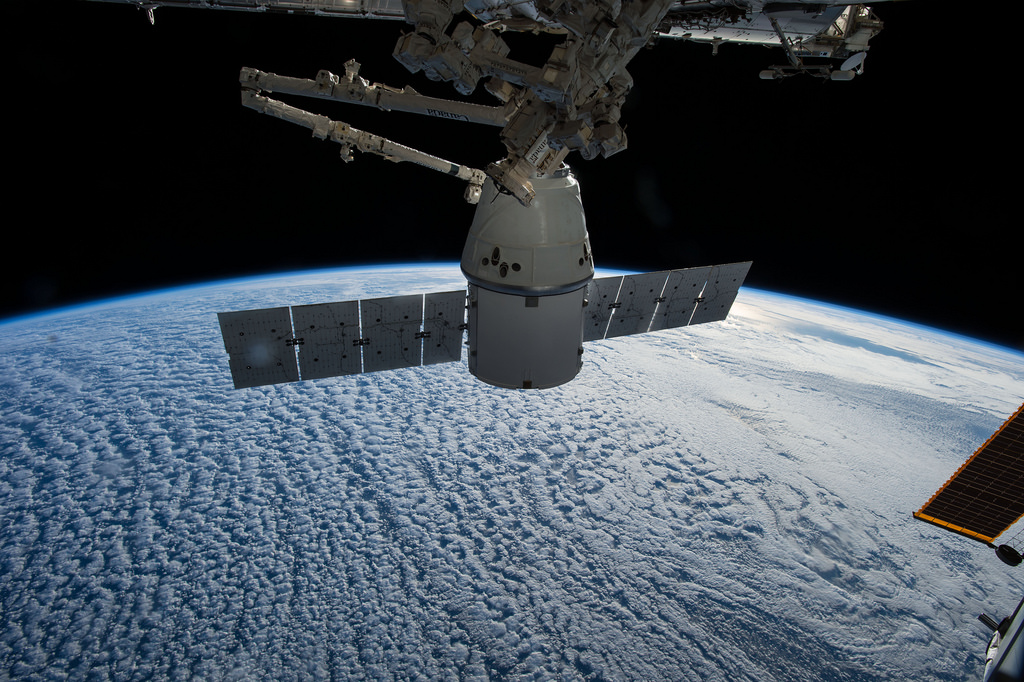
CLICK TO ZOOM – Expedition 42 commander and NASA astronaut Barry Wilmore and European Space Agency astronaut Samantha Cristoforetti used the Canadarm2 robotic arm to grapple the SpaceX Dragon (CRS-5) ship on Jan. 12 2015, two days after its launch from the Cape Canaveral Air Force Station, Florida. Dragon was attached to the station’s Harmony module three hours after it was grappled, where it spent a month being unloaded. Image Credit: NASA
The SSEP Mission 6 to ISS Yankee Clipper II payload of student experiments is set to return to Earth today aboard the SpaceX-5 Dragon spacecraft, the same vehicle that brought it to ISS on January 12, 2015. The fifth and final Crew Interactions with the Mission 6 experiments were carried out on February 8, 2015, at 6:55 am EST, by ISS Commander Barry Wilmore. The interactions included de-activation of 7 of the 17 experiments. Yankee Clipper II was then moved from ISS to Dragon in preparation for unberth today. All Yankee Clipper II student flight teams will be standing by for receipt of their flight experiments, harvesting, and analysis. NCESSE will be conducting a pre-harvesting inspection of the mini-labs with all teams.
WATCH THE UNBERTH OF DRAGON LIVE RIGHT HERE ON THE NASA TV PORTAL BELOW
You are invited to watch the unberth at ISS LIVE on NASA TV in the video portal below. NASA will be starting live coverage at 1:45 pm EST. Also below is the NASA February 4, 2015, press release on Dragon’s return to Earth, which includes details of live coverage.
NASA Press Release, February 4, 2015
NASA TV Coverage Set for U.S. Cargo Ship’s Departure from Space Station
After delivering more than 5,000 pounds of supplies and experiments to the International Space Station last month, the SpaceX Dragon cargo spacecraft is set to leave the orbiting laboratory on Tuesday, Feb. 10.
NASA Television will provide live coverage of Dragon’s departure beginning at 1:45 p.m. EST.
The Dragon spacecraft is scheduled to detach from the Earth-facing side of the station’s Harmony module and release through commands sent by ground controllers in mission control at NASA’s Johnson Space Center in Houston operating the Canadarm 2 robotic arm. Mission control will maneuver Dragon into place for its release, which is scheduled for 2:09 p.m.
Dragon will execute three thruster firings to move a safe distance from the space station for its deorbit burn at approximately 7 p.m. The capsule will splash down in the Pacific Ocean around 7:44 p.m. The deorbit burn and the splashdown will not air on NASA TV.
In the event that weather at the landing zone does not permit a Feb. 10 departure, the next available opportunity is on Feb. 11 with a 1:17 p.m. departure time with NASA TV coverage beginning at 12:45 p.m.
Dragon currently is the only spacecraft able to return cargo from the space station to Earth. It will return about 3,700 pounds of cargo, including science samples from human physiology research, biology and biotechnology studies, physical science investigations and education activities sponsored by NASA and the Center for the Advancement of Science in Space (CASIS) in Melbourne, Florida. CASIS, a nonprofit organization, is responsible for managing research performed in the U.S. national laboratory portion of the space station.
Dragon launched on the SpaceX Falcon 9 rocket from Cape Canaveral Air Force Station in Florida on Jan. 10 on the company’s fifth commercial resupply mission to the station. It arrived at the station Jan. 12.
For NASA TV schedule and video streaming information, visit:
For more information about the International Space Station, and its research and crews, visit:
For more information about the mission, visit:
-end-
nbsp;
The Student Spaceflight Experiments Program (SSEP) is a program of the National Center for Earth and Space Science Education (NCESSE) in the U.S., and the Arthur C. Clarke Institute for Space Education internationally. It is enabled through a strategic partnership with NanoRacks LLC, working with NASA under a Space Act Agreement as part of the utilization of the International Space Station as a National Laboratory. SSEP is the first pre-college STEM education program that is both a U.S. national initiative and implemented as an on-orbit commercial space venture.
The Smithsonian National Air and Space Museum, Center for the Advancement of Science in Space (CASIS), and Subaru of America, Inc., are National Partners on the Student Spaceflight Experiments Program.



